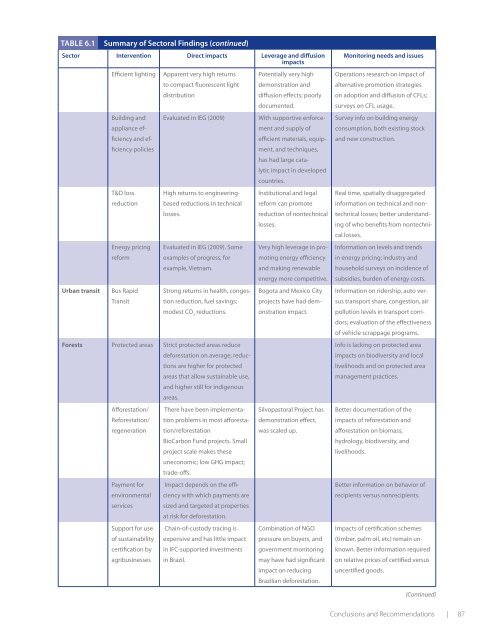The Challenge of Low-Carbon Development - World Bank Internet ...
The Challenge of Low-Carbon Development - World Bank Internet ...
The Challenge of Low-Carbon Development - World Bank Internet ...
Create successful ePaper yourself
Turn your PDF publications into a flip-book with our unique Google optimized e-Paper software.
Table 6.1Sector Intervention Direct impacts Leverage and diffusionimpactsUrban transitSummary <strong>of</strong> Sectoral Findings (continued)Efficient lightingBuilding andappliance efficiencyand efficiencypoliciesT&D lossreductionEnergy pricingreformBus RapidTransitApparent very high returnsto compact fluorescent lightdistributionEvaluated in IEG (2009)High returns to engineeringbasedreductions in technicallosses.Evaluated in IEG (2009). Someexamples <strong>of</strong> progress, forexample, Vietnam.Strong returns in health, congestionreduction, fuel savings;modest CO 2reductions.Forests Protected areas Strict protected areas reducedeforestation on average; reductionsare higher for protectedareas that allow sustainable use,and higher still for indigenousareas.Afforestation/Reforestation/regenerationPayment forenvironmentalservicesSupport for use<strong>of</strong> sustainabilitycertification byagribusinesses<strong>The</strong>re have been implementationproblems in most afforestation/reforestationBio<strong>Carbon</strong> Fund projects. Smallproject scale makes theseuneconomic; low GHG impact;trade-<strong>of</strong>fs.Impact depends on the efficiencywith which payments aresized and targeted at propertiesat risk for deforestation.Chain-<strong>of</strong>-custody tracing isexpensive and has little impactin IFC-supported investmentsin Brazil.Potentially very highdemonstration anddiffusion effects; poorlydocumented.With supportive enforcementand supply <strong>of</strong>efficient materials, equipment,and techniques,has had large catalyticimpact in developedcountries.Institutional and legalreform can promotereduction <strong>of</strong> non technicallosses.Very high leverage in promotingenergy efficiencyand making renewableenergy more competitive.Bogota and Mexico Cityprojects have had demonstrationimpact.Silvopastoral Project hasdemonstration effect,was scaled up.Combination <strong>of</strong> NGOpressure on buyers, andgovernment monitoringmay have had significantimpact on reducingBrazilian deforestation.Monitoring needs and issuesOperations research on impact <strong>of</strong>alternative promotion strategieson adoption and diffusion <strong>of</strong> CFLs;surveys on CFL usage.Survey info on building energyconsumption, both existing stockand new construction.Real time, spatially disaggregatedinformation on technical and nontechnicallosses; better understanding<strong>of</strong> who benefits from nontechnicallosses.Information on levels and trendsin energy pricing; industry andhousehold surveys on incidence <strong>of</strong>subsidies, burden <strong>of</strong> energy costs.Information on ridership, auto versustransport share, congestion, airpollution levels in transport corridors;evaluation <strong>of</strong> the effectiveness<strong>of</strong> vehicle scrappage programs.Info is lacking on protected areaimpacts on biodiversity and locallivelihoods and on protected areamanagement practices.Better documentation <strong>of</strong> theimpacts <strong>of</strong> reforestation andafforestation on biomass,hydrology, biodiversity, andlivelihoods.Better information on behavior <strong>of</strong>recipients versus nonrecipients.Impacts <strong>of</strong> certification schemes(timber, palm oil, etc) remain unknown.Better information requiredon relative prices <strong>of</strong> certified versusuncertified goods.(Continued)Conclusions and Recommendations | 87
















